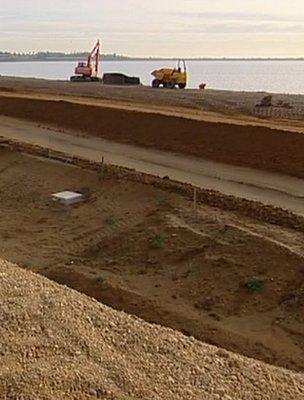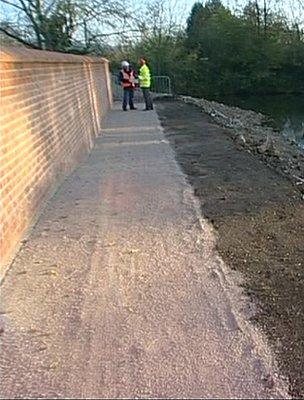The reality of adapting to uncertain climate forecasts
- Published

Ardingly Resevoir, southern England, is only about 12% full - raising concern about future water supplies in the region
Imagine spending millions of pounds on a barrier to defend thousands of homes from a river bursting its banks but not being totally sure how high it might rise.
Think of expanding a reservoir to hold more water for a rapidly growing population but without clear advice on how rainfall patterns may shift and affect supplies.
Spare a thought for the wine-maker trying to decide which variety of grape to plant knowing that it might take five years to see if a new one thrives.
These are the challenges faced by everyone planning for projects where the future climate may have potentially serious implications.
In the jargon, this is known as "climate adaptation" - but it is easier talked about than acted upon because the forecasts are so uncertain.

Parts of the UK are statistically drier than parts of the Middle East
The basic assumption, based on computer models, is that Britain will experience warmer, drier summers and milder, wetter winters in the decades ahead.
But there are large uncertainties about what may happen and translating sweeping generalisations into meaningful reality on the ground is difficult.
Climate scientists admit their models are too coarse to provide a detailed guide, especially given that British weather is so changeable as it on the front-line of different air masses.
So how much faith can be put in these predictions and is it worth spending serious money acting on them?
According to Lord Krebs, who led a study into adaptation for the Climate Change Committee - the official body advising the government, the message is clear:
"I don't think there's a need to panic now," he told me.
"There are many decisions which we can put off for the future.
"But if we look at long term decisions, decisions with a long term impact, if we don't get it right now we could be sleepwalking into a disaster for future generations.
"This is not a panic button but it's saying let's be clear-sighted about the future impacts of climate change."
Going with the flow
In practice, that can mean spending a bit more money now to make it easier to respond more quickly in the years ahead.

The Environment Agency has invested in new flood defences to protect homes in Nottingham
One example is in Nottingham, which was severely flooded by the River Trent in 2000, where the Environment Agency is investing in a defence scheme.
I watched pile-drivers hammering huge steel sheets into the mud as part of a 27km-long barrier to protect 16,000 homes.
Climate forecasts suggest that rainfall may increase by 25-30% by 2050 and that the flow of the river could increase by up to 30% in the winter but there is no certainty about this.
If the agency followed this advice to the letter the flood wall would be another 25cm higher - at an extra cost of £5million.
Instead the foundations being laid are slightly stronger than needed so that an extra topping can be added if needed in future.
John Curtin, of the Environment Agency, explained that "we've designed this scheme so we're not wasting money now but we can adapt if we need to.
"We want to make sure we can adapt if climate change materialises, or if it doesn't.
"The threat might not be that bad but we can adapt if it is."
Climate confusion
In Essex, the driest county in the UK, a slightly different approach is taken by the water company, Essex & Suffolk Water.
In one of the country's largest construction projects, Abberton Reservoir is being expanded to hold more water.
It is part of a scheme including a system to channel water from as far away as Norfolk and store it locally.
The main driver is the rapid rise in population in the region rather than any response to climate forecasts.
In the view of Martin Lunn of Essex & Suffolk Water, climate models are "not something that we could plan against - they're not accurate enough, the science isn't there for small areas like Essex or even East Anglia.
"We're not ignoring them, but we're not spending money on them. We are aware of the changes there could be - lower river flows, hotter summers, wetter winters.
"But we have to be careful until the science is more definite or we'd risk wasting money."
In Gloucestershire too, at the Three Choirs Vineyard, the prevailing view is one of confusion about what climate change might mean.
Martin Fowke says that although temperatures have become warmer and it's now possible to make red wine, usually only possible in warm conditions, but "it's almost impossible to understand what could happen next.
"For every report you hear saying global warming happening at a certain rate, the next day there's someone saying something completely different.
"We have to take a fairly sensible route through the middle at the moment. We have to go on gut instinct which tells me we're certainly going to need some new varieties but we're not going to suddenly grub up whole vineyard."
The gamble for wine-makers is whether to plant popular varieties of grape that might not do well if the conditions do not change as forecast, and it might take five years to know.
The government is anxious for companies and organisations to be alert to the risks of climate change and to adapt to them.
But in many cases that is easier said than done - until the forecasts become more certain.
- Published28 January 2011
- Published22 October 2010